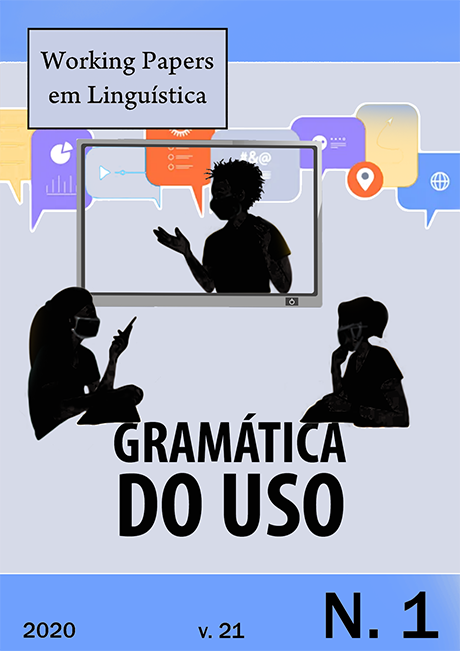The multifunctionality of "aliás": semantic values in functional perspective
DOI:
https://doi.org/10.5007/1984-8420.2020v21n1p220Abstract
This article aims to study the linguistic element “aliás”, observed in different contexts of use in which it is recruited. According to the Brazilian Grammar Nomenclature (NGB), “aliás” is classified as a denoting word of rectification. In grammars and dictionaries by established authors, this item is classified according to the NGB and as an adverb. During the research, we verify the categorical fluctuation of this element, which also assumes characteristics of conjunction, reformulative connector and argumentative operator, in addition to the aforementioned traditional classification. We observe its frequency and uses in oral texts of the Discourse & Grammar corpus in the light of Usage-based Functional Linguistics. The analyzed factors, based on the semantic aspect, are the following: positions in the texts, frequency of use, education levels and textual genres. The analysis points out that this element, widely used in Brazilian Portuguese, serves the various discursive functions, such as reformulation, integral rectification, partial rectification, inclusion (of arguments), among others. Notwithstanding the classification imposed by the NGB, the results point to a versatility of this linguistic element when analyzed in the contexts in which it is instantiated.References
AZEREDO, José Carlos de. Gramática Houaiss da Língua Portuguesa. São Paulo: Publifolha, 2014.
BECHARA, Evanildo. Moderna Gramática Portuguesa. Rio de Janeiro: Nova Fronteira, 2009.
CEZARIO, Maria Maura; CUNHA, Maria Angélica Furtado da. Linguística Centrada no Uso. Rio de Janeiro: Mauad x FAPERJ, 2013.
CUNHA, Celso; CINTRA, Lindley. Nova Gramática do português contemporâneo. Rio de Janeiro: Nova Fronteira, 1985.
CUNHA, Maria Angélica Furtado da. A linguística centrada no uso (ou linguística cognitivo-funcional). In: SOUZA, Medianeira et al. (Org.). Sintaxe em foco. Recife: PPGL / UFPE, 2012, p. 29-49.
FERREIRA, Aurélio Buarque de Holanda. Miniaurélio: o minidicionário da língua portuguesa. 6. ed. Curitiba: Publifolha, 2007.
GIVÓN, Talmy. A compreensão da gramática. Tradução Maria Angélica Furtado da Cunha, Mário Eduardo Martelotta, Filipe Albani. São Paulo: Cortez; Natal, RN: EDUFRN, 2012.
Grupo D&G. Disponível em: http://www.discursoegramatica.letras.ufrj.br/. Acesso em julho de 2017.
KOCH, Ingedore Grunfeld Villaça. A inter-ação pela linguagem. São Paulo: Contexto, 2015.
OLIVEIRA, Heleno Fonseca de. Os conectores reformulativos. SCRIPTA, Belo Horizonte, v. 5, n. 9, p. 229-233, 2º sem. 2001.
OLIVEIRA, Mariângela Rios de. Contexto: definição e fatores de análise. In: OLIVEIRA, Mariângela Rios de; ROSÁRIO, Ivo da Costa do. (Org.). Linguística centrada no uso – teoria e método. Rio de Janeiro: Lamparina; FAPERJ, 2015, p. 22-35.
Downloads
Published
Issue
Section
License
Copyrights belong to the authors, who allow the Working Papers em Linguística journal to publish their work. Total or partial reproduction requires the Editorial Board's authorization. Names and adresses in this website are exclusively used for the journal's purposes and are not available for other purposes and/or third parties.
![]()
This publication is licensed under Creative Commons - Attribution-NonCommercial - 4.0 International.


